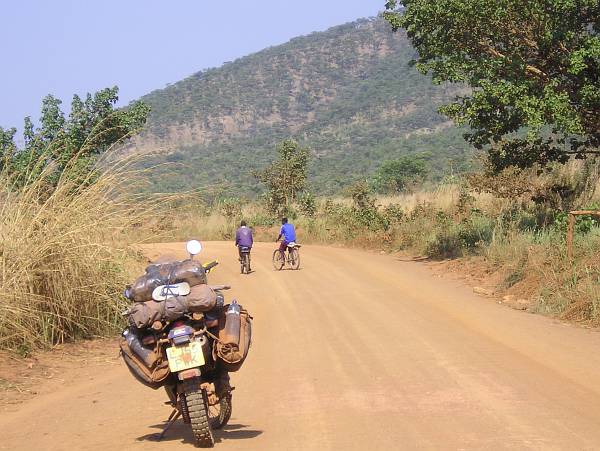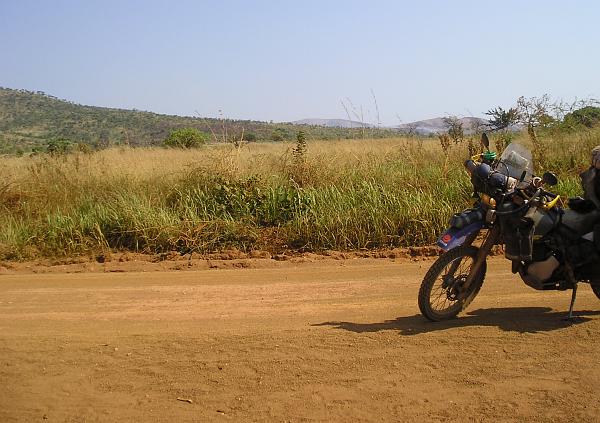Kigoma
From Nyakasanza the next morning I set off south to the T junction at Nyakanazi fifty miles away. This would be decision time.
Right for the two hundred mile dirt 'main road' to Kigoma, or left for the tarmac to Kahama, Dodoma and thence Malawi.
I went right as planned, and immediately onto a mediocre dirt road. That deteriorated gradually but insidiously as it left Nyakanazi and its surrounds over a distance of maybe ten miles. It was dry, but became a mixture of everything from pretty good, to deep potholes hardly visible and dust clouds churned up by heavy articulated lorries reducing visibility to a couple of yards as they trundled past.
The ground is a uniform orange-red, the sun high in the sky, so there are no shadows or visible contours to reveal the presence of pot holes, deep rainwater channels, corrugations, or a new entertaining feature, holes and ruts full of talcum powder.
The dust is everywhere, tons and tons of it, and it fills the irregularities in the surface making it impossible to be sure of what is coming up. And riding through piles of it is, I suppose, the advanced lesson after you've learnt how to ride through sand. Which I haven't.
Then there's the main feature - a pair of deep ditches cut by rainwater right across the road, invisible until you're on top of them, followed immediately by a big hole full of deep dust. And sometimes with a speeding bus going the other way towing an impenetrable dust cloud behind it. After nearly being thrown off twice by this combination I was thinking seriously of turning around, missing out on Lake Tanganyika, and heading back to the tarmac. I would, after all, have to return this way after visiting Kigoma. Except for the ferry, it's a dead-end.
But two things persuaded me otherwise, first I wasn't in a hurry, and second I hoped that the road would improve once we got well away from the traffic of the town. Which more or less was the case. Except there were a few more towns between Nyakanazi and Kigoma.
And between towns it wasn't all straightforward. Max speed here most of the time was around 33 mph with occasional stretches where almost 40 mph was possible, but this had to be tempered with extreme caution as a thick layer of dust covered everything, all uniform in colour, effectively hiding all obstructions underneath.
And as you'd expect in a country subject to two rainy seasons a year, the road is cambered throughout its length, sloping down from the centre towards drainage ditches along each side.
The deep and barely visible dust holes slow you down immediately and a bit fiercly, but also remove all steering ability. And it's the deeper drainage ditches alongside the road that you head for. So even when the road is feeling pretty good and secure, a lot of caution is called for, especially when you're on your own.
On the exit of one town, the road ahead suddenly changed in appearance. It had been newly graded! Bliss! In places it was better than African tarmac. But the road was hilly and bendy and not visible very far into the distance, so I wondered how long this would last. Around which bend would the old surface return? Or would it continue like this for the entire 150 miles remaining to Kigoma?
After five miles I found out, but had the useful escort of a heavy fuel tanker ahead to help blaze a trail.
The road is graded by a huge digger shovelling massive piles of earth, a couple of feet deep or more, onto the surface. Then a road roller rolls it down, followed by the grader planing it all level and the roller rolling once more.
Well, around a bend and at the foot of a hill I caught up with the tanker. It had started to negotiate the hill, about a mile long, that had just been covered with piles of earth two feet deep. The road roller was by the roadside, with the grader also in attendance, but both doing nothing.
Well, the tanker did an excellent job, at about half a mile an hour, of leaving a neat pair of perfectly flat tyre tracks in its wake, just right for me to follow easily behind. And at the top of the hill we found out why this bit of road was being regraded. A series of hills and valleys stretched out ahead for fifteen miles, the road weaving up and down them, and the recent rainy season had done its worst.
So that was a pretty slow and shaky 15 miles.
Thereafter it was a regular pattern, fairly OK outside the towns, tricky and slow going through them.
There were two hotel possibilities that I knew of, at Kibondo and Kasulu.
On reaching the first of these I was confident of reaching Kasulu, another hundred miles, in good time, and ended up there for the night in a pretty good modern hotel, which was a surprise to find, and only five pounds including breakfast.
So Wednesday morning found me leaving Kasulu for the final fifty miles to Kigoma. It was the same as the previous day, except for one brilliant stretch of maybe ten miles, nice and smooth, maybe recently graded, and also almost devoid of pedestrians and cyclists.
These are the main users of this road and have to be taken into account when deciding if you might have to swerve suddenly, or as suddenly as you can, to avoid a large hole ahead. Half the bicycles are carrying massive loads, bananas, firewood, water, bales of hay, you name it, and they too are prone to swerving around the ruts and ridges. I never saw one fall off, but if one did, carrying three big branches of bananas, it would be quite a task to avoid it all.
So on that nice smooth and quiet section I was able to relax concentration a little, and the idea of taking a photo or two entered my head.
Stopping to take photos isn't actually that easy. There's not a lot of traffic but buses and trucks pass regularly. There are the drainage ditches either side, and the road slopes steeply into them at its edge. There are pedestrians and cyclists going by as well.
And when the going is tricky, stopping for a photo is the last thing in your head.
Anyway, this is the scene about halfway between Kasulu and Kigoma.




The road camber here slopes steeply into the drainage ditch, so this is as close to the edge as I could get otherwise the bike wouldn't sit on its sidestand.
Taking photos anywhere out of doors in this part of Africa has to be done with care. For instance there's a large refugee camp between Kasulu and Kigoma, off the road towards the border with Burundi. I was well past it when taking these photos. The presence of that camp might have been the reason for this stretch of road having been graded.
In Kigoma there are white UNHCR Toyotas to be seen on every street.
Fifteen miles before Kigoma was this:

Tarmac! Somewhere over the edge is Lake Tanganyika, and the Democratic Republic of Congo in the far distance.

The tarmac went all the way down to Kigoma, via dozens of hairpin bends.
There's beach camping in Kigoma, but down a five-minute flight of steps from the nearest access track and some way out of town. And only two pounds cheaper than the hotel I was lucky enough to find a room in.
There's some sort of government conference on in town, so many hotels are full.
But I found this:

Sunset over Lake Tanganyika from the terrace of my room!


